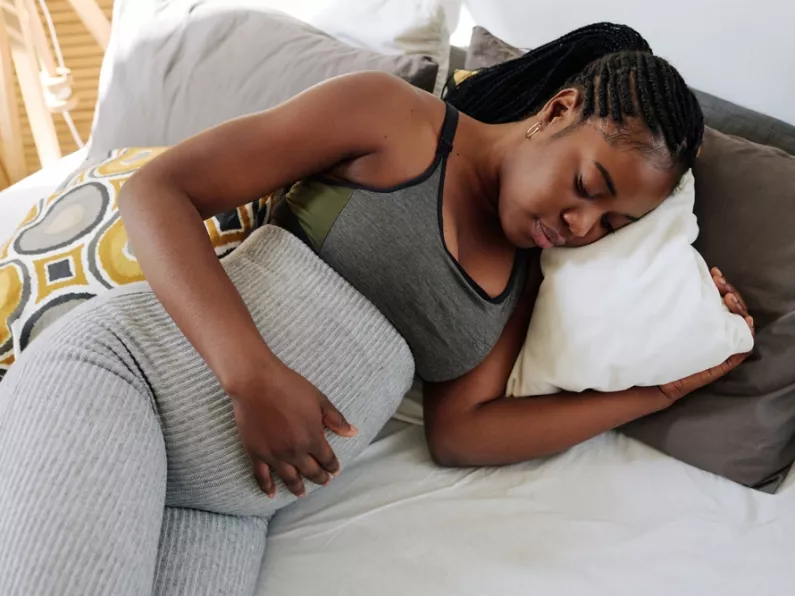Pregnancy is tiring, and pregnancy sleep positions can be difficult to figure out.
It's exhausting work growing a tiny human and then, as your pregnancy progresses and your bump gets bigger, it can be challenging to find a comfortable position to sleep in - not to mention the endless trips to the bathroom to pee during the night!
More than two-thirds of pregnant women experience sleep problems over the course of their pregnancy.
But we're here to discuss pregnancy sleep positions and how to get the best night's sleep.
Pregnancy sleep positions
Most experts agree that once your bump starts to grow, it's best to sleep on your left side with your knees bent.
Not only is sleeping on your side more comfortable, it also helps improve your blood flow - ensuring that vital organs and the baby receive the nutrients and oxygen they need.
It also decreases the likelihood of swelling.
This might be difficult, especially if you're used to sleeping on your stomach, but you'll get used to it.
Sleep positions to avoid
Sleeping on your right side can put pressure on the liver, so it's not ideal.
In addition to discouraging right-side sleeping for long periods of time, experts typically caution against sleeping on your back during the second and third trimesters of pregnancy.
As pregnancy progresses, back sleeping causes the weight of the uterus to place pressure on a main artery called the aorta and this can make it harder for the heart to pump blood to you and your baby.
Sleeping on your back can also put pressure on your spine and exacerbate lower back pain, which affects a majority of pregnant people.
In the second and third trimesters of pregnancy, people who wake up on their backs should simply return to their sides.
How to find a comfortable position
If you are used to sleeping on your stomach or back, adjusting to side sleeping may be a challenge.
Even if you normally sleep on your side, it might be difficult to find a comfortable sleeping position during pregnancy.
So here are some strategies that can help ease your discomfort and promote a good night’s sleep.
- Bend your knees: Health care providers recommend side sleeping with one or both knees bent, which can help support your back.
- Use pillows: To reduce discomfort and pain, you can place a pillow between your legs, against your lower back, or beneath your abdomen. You can also try a full-body pillow, many of which are designed specifically to support pregnant sleepers.
- Find a comfortable mattress or mattress topper: Materials that relieve pressure points, such as egg crate mattress toppers, may help relieve hip pain brought on by side sleeping.
- Elevate your upper body: If you have heartburn at night, try raising the head end of your mattress or bed. Sleeping slightly upright may help relieve your symptoms.
- Sleep on the left side of the bed: You may be more likely to sleep on your left side if you move to the left side of the bed.
Sleep better during pregnancy
Apart from figuring out what position helps you sleep better during pregnancy, there are several other things you can do to promote quality sleep.
- Keep a regular sleep schedule: Going to bed and waking up at the same time every day can help you take advantage of your natural sleep-wake cycle and fall asleep more easily. Maybe even take a warm bath before bedtime. But be sure to speak to your doctor about safe water temperature.
- Make the bedroom a sanctuary: Remove bright lights, limit noise, and keep digital distractions away.
- Nap as needed: If you have trouble sleeping through the night, you can nap during the day to make up for lost rest.
- Use relaxation exercises to manage stress: Stress prevents many pregnant people from sleeping soundly. Relaxation exercises may help calm your body in preparation for sleep.
- Cut d0w on food and drinks in the evening: While it's important to stay hydrated throughout the day, drinking too many fluids or eating a big meal at night can make it harder to sleep.
- Limit caffeine intake: Caffeine interferes with sleep, so you may wish to reduce your consumption of coffee, tea, and caffeinated soft drinks.
- Consider prenatal vitamins: Taking prenatal vitamins, such as iron and folic acid, not only helps the baby receive needed nutrients but may also alleviate the symptoms of restless legs syndrome, a sleep disorder that commonly affects pregnant people. Be sure to consult a health care provider before introducing any new supplements.
- Exercise regularly: Experts recommend that most pregnant people maintain a regular exercise routine throughout their pregnancy. It is best to avoid contact sports or otherwise risky activities, but yoga, swimming, and walking can be good options for physical activity during pregnancy. Stretching and strengthening exercises, in particular, may help limit lower back pain and lower the chances of experiencing leg cramps. While exercise generally helps promote sleep, avoid vigorous activity before bedtime so that your body has time to wind down.
Talk to your doctor
It's important to talk to a doctor if you have trouble getting quality sleep or have other symptoms of a sleep disorder, as some conditions have been linked to a higher risk of pregnancy complications.
A health care provider can provide suggestions and treatments for pregnancy-related sleep disorders like obstructive sleep apnea, heartburn, or restless legs syndrome.
